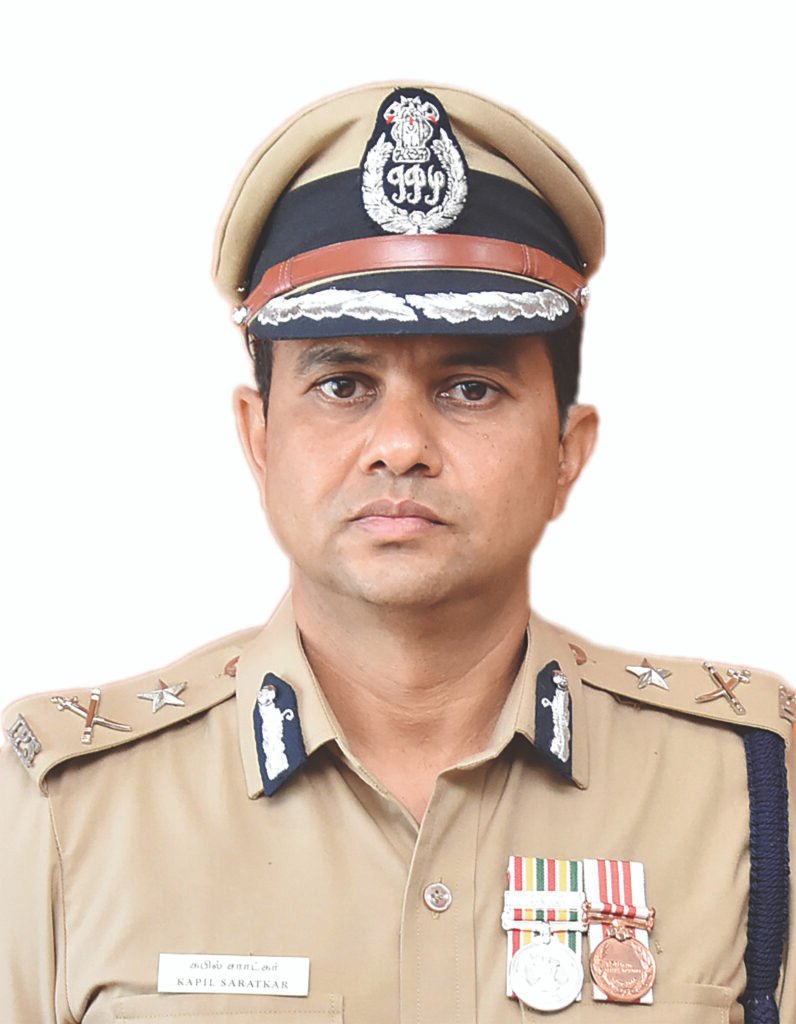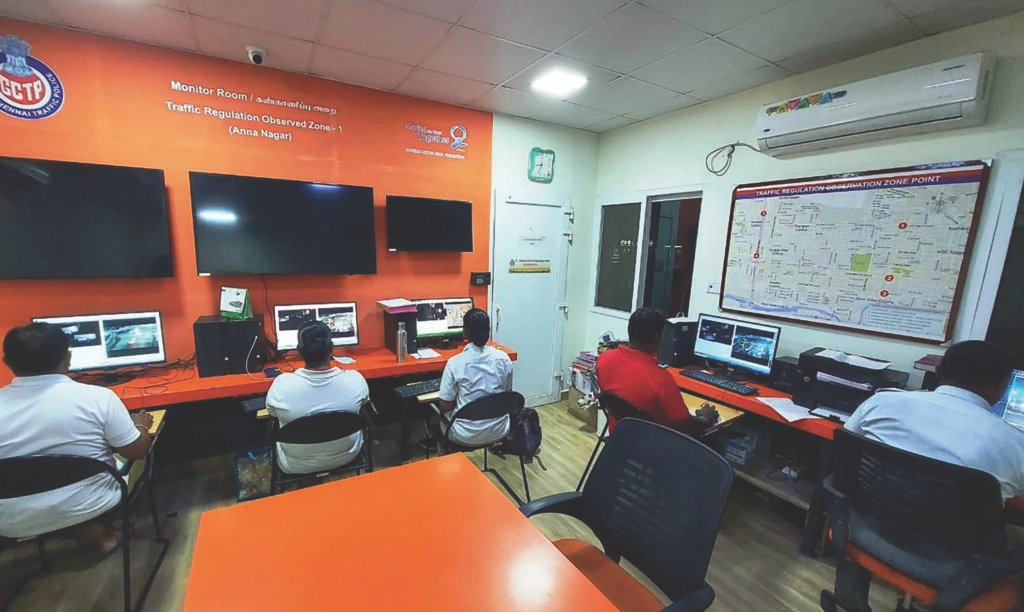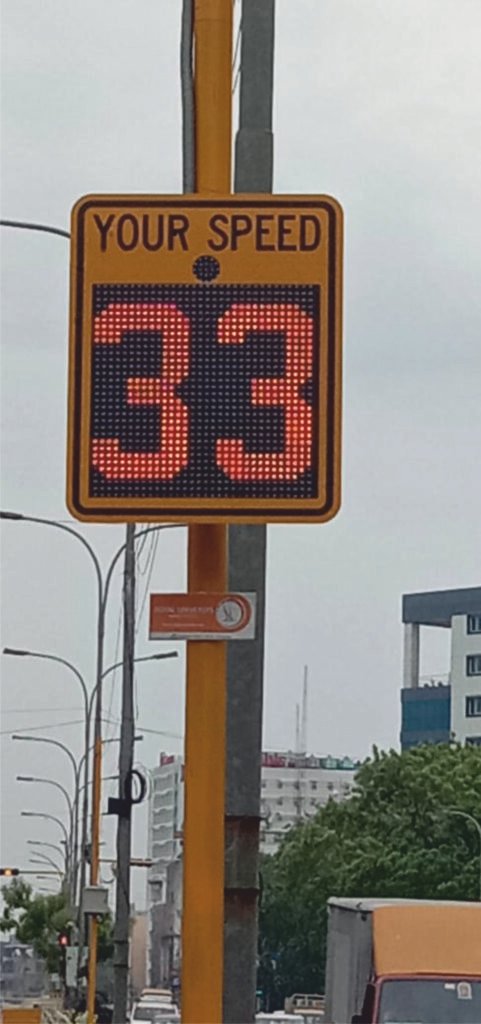 From enforcement to accident reduction and awareness to technology, Kapil Kumar C. Saratkar, IGP/ Addl. Commissioner of Police (Traffic), Greater Chennai Police, speaks to Mangala Chandran about the A to Z of traffic management and safety in the City.
From enforcement to accident reduction and awareness to technology, Kapil Kumar C. Saratkar, IGP/ Addl. Commissioner of Police (Traffic), Greater Chennai Police, speaks to Mangala Chandran about the A to Z of traffic management and safety in the City.
What is the structure of the Chennai traffic police?
I am heading the Greater Chennai Traffic Police (GCTP). There are two JCPs, four DCPs, 11 ACP level officers. There are 56 traffic police stations which take care of enforcement. Traffic enforcement means regulating traffic and fining and issuing challans to violators.
The second part of our work is investigation of accidents. There are four ACP level officers all over the city with 11 traffic investigation wings under them, each headed by an Inspector.
The third part is planning. A DCP, an ACP and four Inspectors look after planning, control room and unit. Every enforcement police station has one Inspector, four to five Sub-Inspectors and around 50-60 constables. This is the overall structure of GCTP and there are around 3,500 police officers and other personnel.
How strong is the enforcement mechanism for road safety?
The Chennai traffic police department registers around 10,000 cases every day under the Motor Vehicle Act and Rules for violations. Out of these, 7,000 are registered by physical interception – the officers stand on the roads and stop the traffic violators. The remaining 3,000 come from electronic surveillances, automatic number plate recognition and CCTV cameras including two interceptor vehicles.
Cases can be registered every day under 32 heads. We also conduct special drives during which focus is on one or two particular areas, such as a pillion rider helmet drive or triples. We usually get 3,000-4,000 cases under one special drive category itself.
Under the 7,000 cases registered by physical interception, there are two categories. One is actually stopping the person and registering a case via an e-challan machine. In the second, the traffic violator is not actually stopped, for example, for a stop line violation at a signal, a constable takes a photo with his personal mobile and makes an entry in the diary. A constable cannot register a case himself but passes on the picture to his Special Sub-Inspector who registers the case. These are called the B-diary cases.

Methodology for fining
The real change will only come when violators actually pay the fine. We have realised that only 10 to 12% of the people pay their fines on the spot. Others don’t pay at all or pay later. Upon registration of the case the fine can be paid immediately with a debit or credit card. The second option is to take the challan and the QR code and pay using Google Pay or Paytm. The third is online payment. The fine can also be paid at post offices or e-Seva centres.
As soon as a case is registered, the person under whose name the vehicle is registered gets an automatic SMS with a payment link. If the violator does not pay on the spot, we have three systems to ensure they pay their fine. One is the call centres. Secondly, there is a bulk SMS system wherein a message is sent to those whom a wrong side driving or no entry challan has been issued. Lastly, special drives are conducted for payment of fines during which our officers intercept vehicles, put their vehicle number in the e-challan machine database, and request them to pay if they have pending cases. Many pay there itself or at a nearby e-Seva centre or pay later.
 The focus areas for minimising accidents
The focus areas for minimising accidents
GCTP registers around 20 non-fatal accidents and around one to two fatal accidents daily on an average. Last year, Chennai had 508 fatal accidents — around 1.5 on an average daily. Out of these, in 249 cases, the victim was on a two-wheeler, in 87 cases it was a pedestrian – a total of 336. So in almost around 65 to 70% of the fatal cases, the victim was either two-wheeler borne or a pedestrian.
It was found that the pattern of accidents is totally different in cities from rural areas or those with highways. Unlike highways, where accident-prone places can be identified and causes ascertained, such as a blind curve or road crossing, the reasons for city accidents are not so easily identifiable.
In the city, accidents are spread all over and it is difficult to find out places that are termed hotspots. We have selected some hotspots but if I take 200 hotspots they will not account for 90% of the accidents, they will account only for around 20 to 40% of the accidents. But last year (2022) our fatal accidents were 12% lesser compared to 2021 and now in 2023 also, till date, our reduction in accidents is around 9% over the reduced figure of 2022.
One special category on which we really focus is driving under the influence of liquor. GCTP and GCP together register 150-160 cases daily and during a special drive around 250. The checks are done with a breath analyser machine and cases are registered immediately. We even hold the vehicle, not allowing the person under the influence of liquor to take it. The minimum fine is Rs.10,000. The compliance of payment is almost 80%. For offences like no helmets, wrong side driving, the compliance is less at 30-35%.
The biggest weak link is that there is no provision to compel a person to pay the fine if they decide not to. Not only in Chennai but all over India, the traffic police are facing this problem. There is provision of non-renewal of fitness certificate by RTO in case of pending fines of commercial vehicles but there is no such arrangement for private or white board vehicles.
The enforcement for using helmets is accelerated by booking around 2,500 cases of violation. During the past one-and-a-half-years, helmet compliance has gone up from around 25% to 88%, according to a recently conducted study. Accidents might not have reduced but fatalities have.
Again, we focus on wrong side driving. People always try to take shortcuts, drive wrong side or go into ‘no entry’ roads. This has increased in Chennai due to the ongoing Metro and utilities work. At selected places, we have closed the junctions to enforce U-turns. For wrong side driving we have special drives and we register around 1,000 cases every day. That has contributed to the reduction of accidents. At 11 places, 15 ANPR cameras are installed to monitor wrong side driving with around 700-800 cases getting registered.
Thirdly, we have special drives to curtail overspeeding and underage driving, which are often done together. We target under 18 boys who have no licence, but have fancy bikes and do overspeeding, wheeling and acrobatics. Here, cases are registered against the parents also because allowing an unauthorised person to drive a vehicle is also an offence.
Besides these, encroachments are removed to create pedestrian spaces. The person who otherwise was used to walking on road now starts walking on these pavements which indirectly reduces the number of accidents.
Raising awareness
Under the awareness initiatives, we do anti-honking weeks and helmet drives. The Super Kutty Cop was a good exercise when one lakh cards were distributed to students and they were told to evaluate their drivers, parents or bus or auto rickshaw drivers. The 12 parameters included whether they wear seat belts and helmets and stop at pedestrian crossings. The idea was two-fold — they monitored the driving behaviour of their drivers and became aware of best practices when they would drive in future.
A positive exercise was that on a particular day we located 5,000 vehicles in which the rider as well as the pillion rider were wearing helmets, and awarded them a certificate. The drive was inaugurated by a Commissioner of Police. It is a carrot and stick policy where we have enforcement, punishment, awareness and appreciation also for those who comply.
At the TrafficInfratfech exhibition we also found the lighted pedestrian crossing which draws the attention of people watching their mobile screens on the roads. There are small bollards which turn green when the signals become red and people can walk.
What are the technological advancements being implemented?
The GCTP started TROZ, Traffic Regulation and Observation Zone, in Anna Nagar where at five junctions, 58 cameras automatically register cases for stop line violation, red light jumping, helmets and triples riding. This successful experiment was done in coordination with the CSR of Hyundai Motors and has run for the last three years. In fact, last year the Chief Minister of Tamil Nadu provided Rs.10.5 crore to include more corridors in TROZ. That work will be completed shortly. A corridor will have four or five junctions which will have around 50-60 cameras to register violations. The same thing has again been announced now and additional funds have been provided for three more corridors.
The traffic police department also deploys interceptors which can be put at different places and have an element of surprise. People behave well where there are fixed cameras and do not do so where there are no cameras. We got the idea of interceptors at the TrafficInfratech Expo in Mumbai. Two interceptors have become functional in the last 15 days and started registering cases.
Another takeaway from the expo was the speed display boards that we have put in six places. They note the speed of a vehicle and state the permitted speed limit, adding ‘Go Slow’ or ‘Too Fast’. It is just an advisory and no case is registered.
Thirty fixed speed radar guns are in the process of being put and their integration is going on. This will not be an advisory but will properly note down the speed, will register a case and automatically issue a challan.
The City has both automatic and manual signals but they are run manually due to various reasons such as ambulances on the roads and peak hour traffic. We have realised that our constable is the best person to decide how much time is to be given and to which side of the traffic. The constables operate the signals with a remote control, enabling them to take photos of traffic violations.
On junctions, there is a public address system by which the traffic policemen are able to address the road users, for both traffic related and general issues.
Chennai traffic police have also collaborated with FM channels like Radio City and Hello FM to get 12 hours of recorded music and traffic safety messages.
 TrafficInfraTech Magazine Linking People Places & Progress
TrafficInfraTech Magazine Linking People Places & Progress